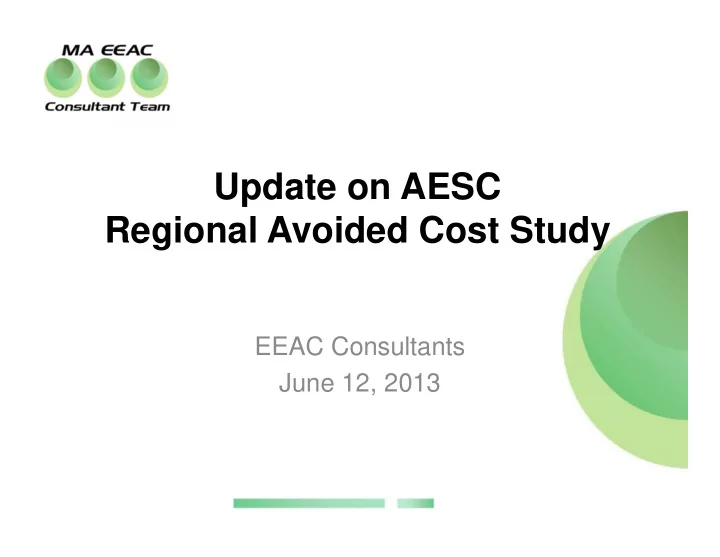

Update on AESC Regional Avoided Cost Study EEAC Consultants June 12, 2013
Regional Avoided Cost Study • Six New England States (ISO-NE area) • Conducted every two years • Provides consistent values for avoided costs throughout all New England states • Used for Energy Efficiency programs only • Synapse is contractor • To be completed by July 8, 2013 (presentation of study results on June 21) • Will be applied going forward for ? (TBD) 2
-- ILLUSTRATIVE ONLY -- Example Calculation of Benefits Benefits = net savings * avoided costs of supply 9.215 kW electricity $50 per kW electric capacity 13,823 kWh electricity $0.08 per kWh electric energy 0 mmbtu natural gas $10 per mmbtu natural gas 0 mmbtu other fuel $13 per mmbtu other fuel 0 gallons water $0.01 per gallon water 0 units non-resources $(variable) per units non-resources Year 1 benefits = (9.215 * $50) + (13,823 * $0.08) + ($10 * 0) + ··· = $1,566.59 � The benefits are calculated for each year of the effective life of the measure and present-valued using a discount rate (calculated per DPU Guidelines) to determine lifetime benefits 3
Avoided Costs – Definitions (for electric) • Avoided capacity. Avoided capacity costs for the AESC 2013 Base Case consist of revenue from demand reductions bid into the FCM and the value of generating capacity avoided by demand reductions that are not bid into the FCM. Levelized annual FCM prices are approximately 61 percent higher than AESC 2011. • Avoided energy. This is the largest component. It consists of the wholesale electric energy price, the REC cost, and a wholesale risk premium. Levelized annual avoided energy costs across the six New England states are approximately 6.9 percent lower on average than those in AESC 2011. • Capacity DRIPE. This is the value of the reduction in capacity market prices due to reductions in demand. The AESC 2013 15-year levelized annual capacity DRIPE value is approximately 45 percent lower on average than AESC 2011. • Energy DRIPE. This is the value of the reduction in energy market prices due to reductions in electric energy use. Levelized annual intrastate energy DRIPE values are approximately 18 percent lower on an annual load-weighted average than AESC 2011. • Electricity cross-fuel DRIPE. This value represents the impact of the reduction in natural gas used for electric generation upon natural gas prices. This value is new for AESC 2013. • Avoided non-embedded CO 2 costs. This is the cost of controlling CO 2 emissions not reflected in wholesale energy market prices. The AESC 2013 15-year levelized annual value is approximately 14 percent higher than AESC 2011. 4
Electric Avoided Costs Illustration of Avoided Electricity Cost Components, AESC 2013 vs. AESC 2011 (WCMA Zone, Summer On-Peak, 15 Year Levelized Results, 2013$) Difference Relative to AESC 2011 AESC 2013 AESC 2011 cents/kWh cents/kWh cents/kWh % Difference Avoided Capacity Costs 1,2 1.11 2.01 0.90 80.7% Avoided Energy Costs 9.36 7.64 -1.73 -18.4% Capacity and Energy Subtotal 10.47 9.65 -0.83 -7.9% DRIPE Capacity 2 1.27 0.69 -0.57 -45.2% Intrastate Energy 3 3.29 2.74 -0.54 -16.5% DRIPE Subtotal 4.55 3.44 -1.11 -24.5% Subtotal: Avoided Capacity and Energy + Intrastate DRIPE 15.03 13.09 -1.94 -12.9% CO 2 Non-Embedded 4 3.52 4.33 0.81 23.0% -1.13 -6.1% Total 18.55 17.42 Notes -Values may not sum due to rounding -Avoided energy costs for Summer On-Peak incorporate avoided REC costs -AESC 2011 values levelized (2012-2026) escalated to 2013$ 1) Avoided capacity costs assumes 100% selling into Forward Capacity Markets 2) Assuming a 55% load factor 3) Values are for Intrastate energy DRIPE 4) For AESC 2013, 2013 CO 2 prices and physical emission rates 5
Natural Gas Avoided Costs COMPARISON OF LEVELIZED AVOIDED COSTS OF GAS DELIVERED TO RETAIL CUSTOMERS BY END USE: AESC 2011 AND AESC 2013 NO AVOIDABLE RETAIL MARGIN 2013$/MMBtu except where indicated as 2011$/MMBtu RESIDENTIAL COMMERCIAL & INDUSTRIAL ALL Non Hot Non RETAIL Heating Water Heating All Heating Heating All END USES Southern New England (a) AESC 2011 (2011$/MMBtu) 7.04 7.04 7.81 7.57 7.04 7.81 7.57 7.57 AESC 2011 (b) 7.27 7.27 8.06 7.83 7.27 8.06 7.83 7.83 AESC 2013 6.14 6.56 6.70 6.59 6.30 6.56 6.45 6.52 2011 to 2013 change -15.51% -9.72% -16.95% -15.84% -13.36% -18.60% -17.59% -16.67% Northern New England (a) AESC 2011 (2011$/MMBtu) 6.94 6.94 7.58 7.39 6.94 7.58 7.39 7.39 AESC 2011 (b) 7.17 7.17 7.83 7.63 7.17 7.83 7.63 7.63 AESC 2013 6.16 7.46 7.88 7.54 6.64 7.47 7.11 7.34 2011 to 2013 change -14.04% 4.00% 0.61% -1.25% -7.35% -4.59% -6.85% -3.86% Vermont AESC 2011 (2011$/MMBtu) 7.06 7.06 8.63 8.16 7.06 8.63 8.16 8.16 AESC 2011 (b) 7.29 7.29 8.91 8.43 7.29 8.91 8.43 8.43 AESC 2013 6.33 6.92 7.11 6.96 6.55 6.92 6.76 6.87 2011 to 2013 change -13.25% -5.12% -20.24% -17.46% -10.23% -22.33% -19.81% -18.53% (a) Massachusetts was included with Northern New England in AESC 2011, but is included with Southern New England in AESC 2013. (b) Factor to convert 2011$ to 2013$ 1.0331 Note: AESC 2011 levelized costs for 15 years 2012 - 2026 at a discount rate of 2.465%. AESC 2013 levelized costs for 15 years 2014 - 2028 at a discount rate of 1.36%. 6
Recommend
More recommend